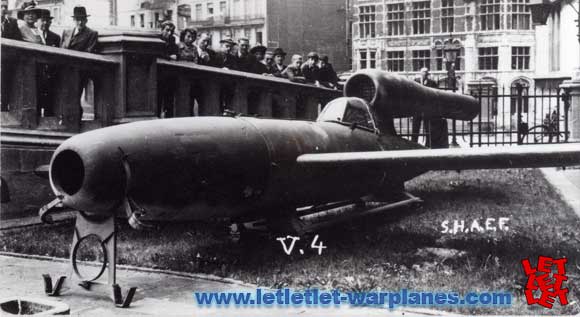Reichenberg

Fieseler Fi-103R summer 1945 outside Continental hotel, Antwerp (SHAEF display)
[dropcap]D[/dropcap]evelopment of the Reichenberg IV began at the Argus Motoren Gesellschaft of Berlin in November 1939. The chief engineer, Guenther Dietrich, worked on a pulse jet engine with flap valves which intermittently allowed air to enter the combustion chamber while continuously injected fuel into the chamber. The pulse jet was tested on or under the Gotha Go 145, Messerschmitt Bf 109, the Dornier Do 217, Messerschmitt Bf 110, Junkers Ju 88 and mounted to the under wing bomb rack of Heinkel H 111 bomber. Design work was carried out by Deutsches Forschungsinstitut fur Segelfug.

RLM ordered production of the V-1 flying bomb on June 1942. Fiesler developed the airframe of pressed steel with an aluminum alloy nose fairing. The rectangular wing was plywood construction with a single steel tube spar. For the piloted version, ailerons were added to the trailing edge. The first successful launch of the V-1 were made on June 19., 1943. During the V-1 initial trials a manned version was considered, but dropped in favor of the Messerschmitt Me 328. After the failure of the Me 328 project, the Reichenberg idea was considered again and conversion work was carried out by the aircraft manufacturer Henschel, under the code name of Reichenberg.
The first real flight was performed in September 1944 at Larz, the Reichenberg being dropped from a He 111. However, it subsequently crashed after the pilot lost control when he accidentally jettisoned the canopy. After that accident was decided to complete trainer version Reichenberg III. Additional cockpit was placed. Initially the Reichenberg was designed for destruction of worthwhile targets (skips, bridges… ). Hanna Reitsch & Heinz Kensche was test pilots included in the Reichenberg development. Pilots were volunteers because of the problems involved in locating a suitable target, diving, releasing canopy and parachuting to safety. Reichenberg was produced in two facilities and some around 175 samples Fieseler Fi 103R-4’s was delivered before production ceased and some 70 pilots were under training when the project ceased in October 1944 owing to a shortage of fuel.
Srecko Bradic





